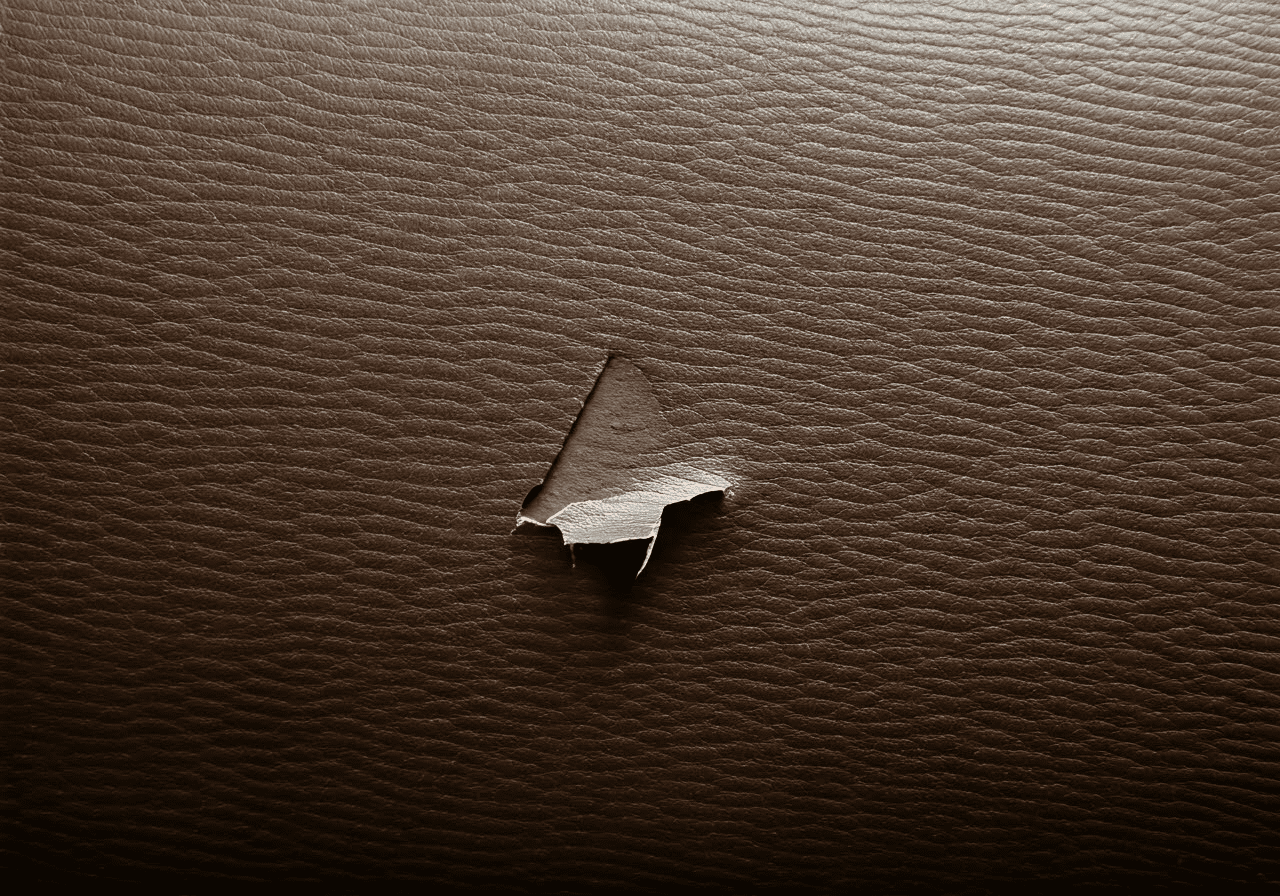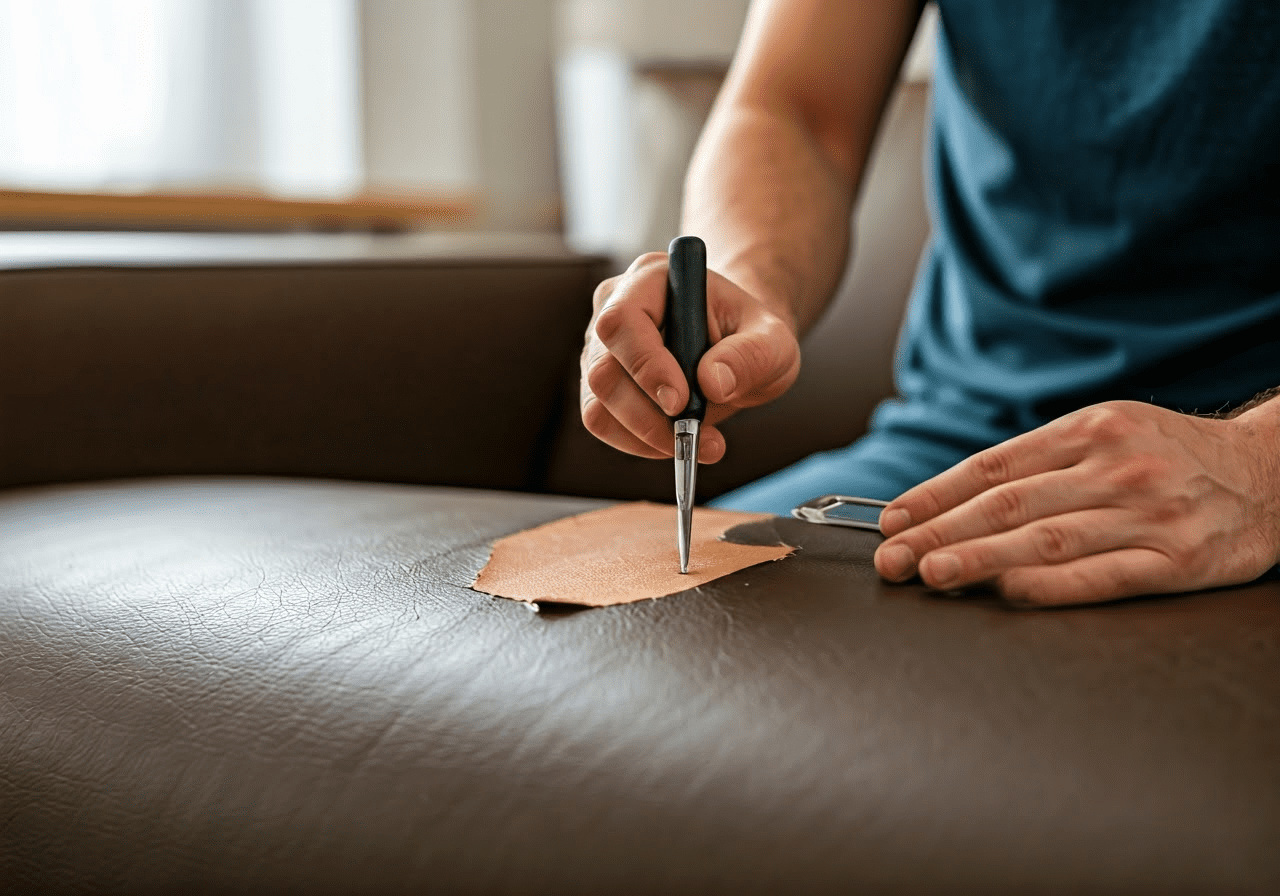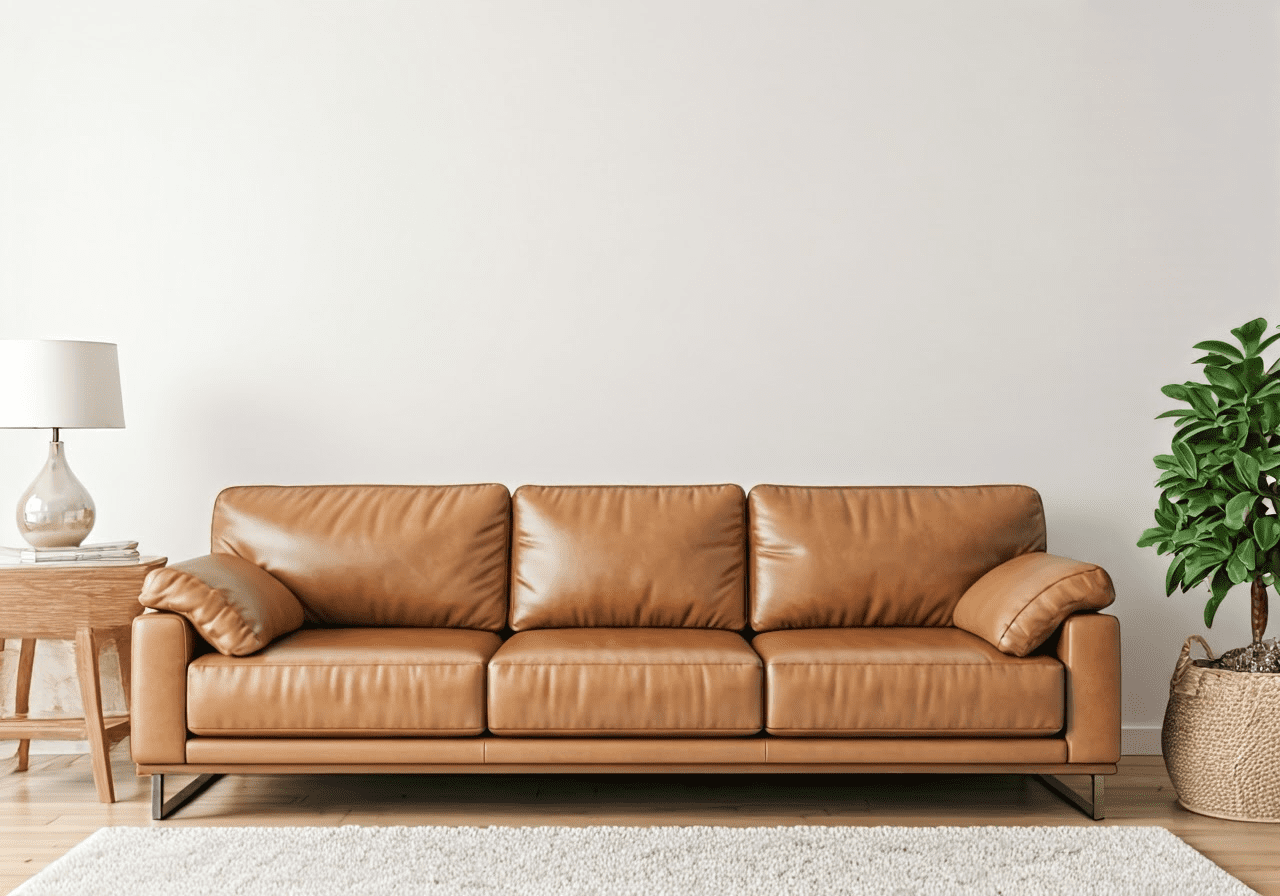Table of Contents
Key Highlights
- Faux leather is a popular alternative to genuine leather, but it can peel over time.
- Peeling occurs when the polyurethane coating separates from the underlying fabric.
- Several factors contribute to peeling, such as UV exposure, abrasion, and improper cleaning.
- Minor peeling can often be repaired using DIY methods, such as leather repair kits or adhesives.
- Preventing future peeling involves regular cleaning, conditioning, and protecting your faux leather furniture from harsh conditions.
Introduction
Faux leather is a nice alternative to real leather for furniture. It looks and feels similar but costs much less. However, faux leather sofas can sometimes peel. This usually happens when the polyurethane (PU) layer breaks down and comes off the fabric. This article will help you know how to spot, fix, and avoid peeling on your faux leather sofa.
Understanding Faux Leather and Why It Peels

Before you try to fix peeling on your faux leather sofa, you should know what faux leather is and why it peels. Faux leather is not real leather, which comes from animal skins. It is made from synthetic materials, usually a fabric like polyester or rayon with a coating of polyurethane (PU) for strength and look.
Peeling happens when the PU coating breaks down over time. This breakdown can be caused by sunlight, heat, wear and tear, and using the wrong cleaning methods. Understanding these causes can help you take steps to prevent damage and make your faux leather sofa last longer.
The Basics of Faux Leather
Faux leather is a general term for fake materials that look and feel like real leather. One common type is “bonded leather.” This is made from tiny pieces of leather mixed with polyurethane. It costs less than real leather, but bonded leather does not last as long and can start peeling.
Another kind is called “vegan leather.” This one usually comes from polyurethane or polyvinyl chloride (PVC). It does not use any animal products. Depending on its quality and how it is made, vegan leather can resist peeling better than bonded leather.
Knowing what type of faux leather is on your sofa can help you with fixing it. It can also help you have a better idea of what to expect from the repair.
Common Causes of Peeling in Faux Leather Sofas
Peeling on faux leather furniture happens for a few reasons. One big reason is UV (ultraviolet) rays from sunlight. These rays weaken the PU coating over time, making it dry and peel.
Everyday use, like rubbing from clothes or pets, also plays a part. Using strong chemicals or rough cleaners on faux leather can damage its protecting layer, which leads to peeling too.
If you know these common reasons, you can take steps to reduce their effects and help your faux leather sofa last longer.
Preparing Your Sofa for Repair
Before starting the repair, getting ready is very important. Good preparation helps the repair materials stick well and gives good results. Begin by cleaning your faux leather sofa thoroughly. This will remove dirt, dust, and any greasy spots that could affect the repair.
Next, carefully check the damage. This step will help you decide the best way to fix it. The assessment will guide you on the right repair methods and materials needed to restore your faux leather sofa properly.
Cleaning the Surface
- Start by vacuuming the whole sofa. Focus on cracks and seams where dirt can hide.
- Then, mix a cleaning solution. Use a mild soap or one made for faux leather care. Stay away from harsh chemicals because they can harm the material.
- Take a soft cloth or sponge, dip it in the soapy water, and gently clean the entire sofa, including the damaged area.
- Rinse the cloth often to avoid spreading dirt.
- After cleaning, dry the sofa completely with a soft cloth or paper towel. A clean and smooth surface will help repair materials stick better, leading to a better result.
Assessing the Extent of Damage
Examine the damaged area closely. Look for signs like peeling, cracking, or flaking. Check how bad the damage is. Is it just in a small spot, or does it cover a large area? See if the peeling is only on the top PU layer, or if it goes deeper and shows the fabric backing.
Gently test the edges where the damage is. If you find loose material that crumbles or flakes off easily, this means the PU coating is very damaged. This kind of damage needs more work than just fixing small peeling.
After you assess the area, you can decide on the best repair method. You may choose a simple touch-up, use a leather repair kit, or go for heavier repairs with leather filler or patches.
Step-by-Step Guide to Fixing Peeling

After getting the sofa ready, you need to fix the peeling. If the peeling is small, a leather repair kit can help. These kits usually come with a compound that matches the color of your sofa. You can put this on the damaged spot to hide it and make the sofa look good again.
If the peeling is worse, you might need to use leather or vinyl adhesives. These adhesives stick the peeling layer back to the sofa’s base. You can also use leather filler with these adhesives to make the surface smooth.
Using Leather Repair Kits for Minor Peels
Leather and vinyl repair kits are a simple way to fix minor peeling on your faux leather sofa. These kits often include a color-matched compound, which is a type of leather filler putty. You can apply it right to the peeling areas.
First, clean the damaged area gently with a soft cloth. This will help remove loose bits. Next, follow the instructions to put a small amount of the repair compound on the damaged area. You can use a putty knife or your fingertip to spread it smoothly. Build up the compound in thin layers until it is even with the rest of the surface.
After that, let the repair compound dry completely as per the instructions. When it’s dry, take some fine-grit sandpaper to softly buff the area. This will help it blend in nicely with the rest of the faux leather.
Applying Leather or Vinyl Adhesives for Larger Areas
For bigger areas where the faux leather is peeling, you need a special leather or vinyl glue. This glue is made to stick well to both the PU coating and the fabric backing of faux leather.
First, clean the affected areas well and let them dry completely. Then, put a thin, even layer of the glue on both the peeling PU layer and the exposed fabric. Carefully line up the peeling layer and press it down onto the glued fabric. You can use clamps or weights to keep it pressed while the glue dries.
To make the repair stronger, you can put a layer of leather filler over the glued area. This step will help create a smooth surface that looks good with the rest of the faux leather.
Techniques for Recoloring and Sealing the Sofa
Once the repairs are done and the filler is fully set, you can start recoloring and sealing the fixed areas. For the color, use dyes or acrylic paints designed for leather. They stick well and last a long time.
Pick a color that is very close to your sofa. Use a soft brush or a sponge to apply it to the repaired spots. Apply the paint in thin, even layers, making sure each layer is dry before adding more.
Finally, seal the repaired parts with a leather sealant or a clear acrylic topcoat. This protects the repairs from fading, cracking, and more damage. It will help keep your sofa looking good for longer.
DIY Solutions for Faux Leather Repair
You can use DIY methods for small repairs instead of commercial kits and adhesives. For tiny cracks and scratches, mix acrylic paint with a fabric medium to make a simple filler. For big tears, use fabric patches to cover them up.
These DIY methods might not last very long. However, they can help you hide damage at a lower cost.
Homemade Mixtures for Small Touch-Ups
For small touch-ups on faux leather, you can use a mixture of acrylic paint and fabric medium. This DIY method is affordable and really good at hiding scratches, scuffs, and small flaws.
First, choose an acrylic paint that is close to the color of your faux leather. Mix equal parts of the paint and fabric medium. You want the mix to be balanced—not too thick or too runny. Take a fine-tipped paintbrush and gently dab the mixture onto the area that needs fixing. Make sure it blends well with the other parts of the faux leather.
Allow the first layer to dry fully. Then, if needed, you can add more coats for better coverage. Keep in mind, this method will not fix peeling issues. However, it can hide little flaws and make your faux leather look better overall.
Crafting a Patch for Large Tears or Peels
While it may not be the best option, making a patch can be a quick way to hide big tears or peeling spots on your faux leather furniture. Choose a strong material like vinyl or a similar faux leather for the patch.
Measure and cut the patch a bit bigger than the damaged area, making sure it goes beyond the edges of the tear or peel. Depending on how bad the damage is and the type of fabric you choose, you can either stitch the patch by hand onto the faux leather or use a strong glue meant for fabrics.
Keep in mind that this is just a temporary fix. A well-made patch can cover the damaged area well, giving you a good look until you can do a more permanent repair or replacement.
Maintaining Your Faux Leather Sofa Post-Repair

After you work hard to fix your sofa, it is important to keep up a regular maintenance routine. This helps avoid future peeling and makes your sofa last longer. Clean your sofa often with a soft cloth and a mild soap solution. This will help take away dirt and grease that can cause damage.
Also, think about using a faux leather conditioner every few months. This keeps the material soft and stops it from drying or cracking. By taking care of your sofa, you can make sure your hard work lasts.
Regular Cleaning and Conditioning Tips
Regular cleaning is very important to keep your faux leather furniture looking good and lasting longer. Dust and dirt can scratch the PU coating slowly over time. So, try to dust your furniture every week. You can use a soft, dry cloth or a vacuum cleaner with a soft brush to help stop dirt from building up.
For a deeper clean, use a gentle, pH-neutral soap solution. Do not use harsh chemicals, solvents, or rough cleaners. These can damage the protective layer of fake leather, making it more likely to get scratched. After you clean, make sure your furniture is completely dry to avoid water damage.
Every few months, use a leather conditioner to add moisture and keep it from drying or cracking. Pick a conditioner made for faux leather or vinyl. These products are designed to nourish and protect the material without harming it.
Avoiding Future Peeling and Tears
Faux leather sofas are a cheaper choice than real leather. However, they need special care to prevent peeling and tears. One important tip is to keep the sofa out of direct sunlight. UV rays can damage the polyurethane coating over time. Try to place your sofa away from windows, or use curtains or blinds to block the sun.
If your sofa has removable cushions, make sure to rotate them regularly. This helps prevent uneven wear. Also, don’t put your faux leather sofa close to heat sources like radiators or fireplaces. Too much heat can make the material hard and cause cracks.
Lastly, be careful with sharp objects or rough surfaces that could scratch or puncture the faux leather. By following these tips, you can help your faux leather sofa last longer.
Conclusion
Maintaining your faux leather sofa can be easy. First, know what causes peeling. Then, follow the right steps to repair it. This way, you can make it look good and help it last longer. Remember to clean and condition your sofa often to stop peeling from happening again. You can find DIY solutions and repair kits for small or big damage. By taking these steps, you can enjoy your faux leather sofa for many years. If you have any questions or want help, check out our FAQ section for more tips on keeping your faux leather furniture in great shape.
Frequently Asked Questions
Can I prevent my faux leather sofa from peeling?
To prevent peeling on your faux leather upholstery, you can take some simple steps. Some wear and tear is normal, but you can reduce it. Keep your furniture out of direct sunlight for a long time. Use gentle cleaning products and avoid harsh chemicals. It’s also a good idea to clean it regularly.
How often should I condition my faux leather sofa?
After cleaning your faux leather sofa regularly, you should condition it every 2 to 3 months. You can do this more often if you use it a lot or if the environment calls for it. Check your warranty from the manufacturer for specific care tips about your vegan leather upholstery.
What are the long-term solutions for fixing a peeling faux leather sofa?
Long-term solutions for faux leather that is peeling a lot are hard to find. You can try to fix it, but the “Tropical Test Method C” shows that even good bonded leather made with rayon will break down over time. This is true for its polyurethane coating as well. Eventually, you may need to replace the furniture.


